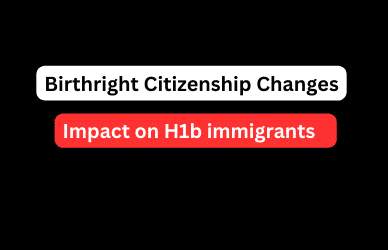Introduction:
Losing your job while on an H1B visa can be a stressful and overwhelming experience. As an H1B visa holder, you have limited time to find new employment or explore alternative options to maintain your legal status in the United States. This comprehensive guide will walk you through the various H1B layoff options available and provide detailed steps on how to execute each one. Whether you’re looking to find a new job, change your visa status, or explore other alternatives, we’ve got you covered.
Find a New H1B Sponsor (60-Day Grace Period)
- The most common option for H1B visa holders who have been laid off is to find a new employer willing to sponsor their H1B visa. Here’s what you need to know:
- Grace Period: You have a 60-day grace period from the date of your termination to find a new job or pursue other options.
- Job Search: Start your job search immediately, focusing on companies that have a history of sponsoring H1B visas.
- Transfer Process: Once you find a new employer, they will need to file an H1B transfer petition on your behalf.
How to execute:
- Update your resume and LinkedIn profile.
- Reach out to your professional network and inform them of your job search.
- Apply to relevant positions on job boards and company websites.
- Attend job fairs and networking events.
- Work with recruiters who specialize in placing H1B visa holders.
- Once you receive a job offer, provide the new employer with the necessary documentation for the H1B transfer process.
- Change of Status to F1 Student Visa
If you’re considering furthering your education, changing your status to an F1 student visa might be a viable option.
How to execute:
- Research and apply to educational programs that align with your career goals.
- Once accepted, request an I-20 form from the school.
- File Form I-539 to change your status from H1B to F1.
- Pay the required fees and submit supporting documents.
- Await USCIS approval before starting your studies.
- Apply for a B1/B2 Visitor Visa
Change to B1/B2 Visa, Travel to Canada, and Reenter the U.S.
This strategy involves changing your status to a B1/B2 visitor visa, traveling to Canada, and then reentering the U.S. under a new status. This option can be useful if you need more time to arrange a new H1B sponsorship or explore other visa options.
How to Execute:
- File Form I-539 to change your status from H1B to B1/B2
- Provide evidence of financial support and ties to your home country
- Explain the purpose of your extended stay in the U.S.
- Once approved for B1/B2 status, plan a trip to Canada
- Before traveling, secure a new job offer and have the employer file a new H1B petition
- While in Canada, apply for a new H1B visa at a U.S. consulate
- Attend the visa interview and await approval
- Once approved, reenter the U.S. under your new H1B status
Important Considerations:
- This strategy carries some risks and should be carefully planned
- Consult with an immigration attorney before pursuing this option
- Ensure you have all necessary documentation for reentry
- Be prepared for the possibility of additional scrutiny at the border
- Remember that approval for reentry is at the discretion of border officials
If you’re married to a U.S. citizen, you may be eligible to adjust your status and obtain a green card.
How to execute:
- File Form I-130 (Petition for Alien Relative) and Form I-485 (Application to Register Permanent Residence or Adjust Status) concurrently.
- Gather required documents, including marriage certificate, birth certificates, and financial information.
- Attend the biometrics appointment.
- Prepare for and attend the green card interview.
- Start Your Own Business with an E-2 Treaty Investor Visa
If you’re from a country with an E-2 treaty with the U.S. and have sufficient capital, you may consider starting your own business.
How to execute:
- Develop a comprehensive business plan.
- Invest a substantial amount of capital in your business.
- Prepare and submit the E-2 visa application.
- Demonstrate that you will be in a position to develop and direct the enterprise.
- Attend the visa interview at a U.S. embassy or consulate in your home country.
- Apply for the O-1 Visa for Individuals with Extraordinary Ability
If you have exceptional skills in your field, you may qualify for an O-1 visa.
How to execute:
- Gather evidence of your extraordinary ability (e.g., awards, publications, media recognition).
- Find a U.S. employer or agent willing to petition for you.
- Have the employer file Form I-129 along with supporting documentation.
- Await USCIS approval before starting work under the O-1 status.
- Explore the L-1 Intracompany Transferee Visa
If you have worked for a multinational company abroad, you may be eligible for an L-1 visa.
How to execute:
- Ensure you meet the eligibility criteria (at least one year of employment with the company abroad in the past three years).
- Have your employer file Form I-129 for the L-1 visa.
- Provide evidence of your qualifying relationship with the foreign entity and your managerial, executive, or specialized knowledge role.
- Await USCIS approval before transferring to the U.S. branch of the company.
- Consider the H-4 EAD Option for Spouses
If your spouse is an H1B visa holder, you may be eligible for H-4 status with employment authorization.
How to execute:
- Ensure your spouse’s H1B visa meets the eligibility criteria for H-4 EAD.
- File Form I-539 to change your status to H-4.
- Once in H-4 status, file Form I-765 to apply for employment authorization.
- Await approval before starting work under H-4 EAD.
- Explore the TN Visa for Canadian and Mexican Professionals
If you’re a citizen of Canada or Mexico, you may be eligible for a TN visa under the USMCA (formerly NAFTA).
How to execute:
- Verify that your profession is on the TN occupation list.
- Secure a job offer from a U.S. employer.
- Prepare the required documentation, including proof of citizenship, educational credentials, and a support letter from the employer.
- Apply for TN status at a U.S. port of entry (for Canadians) or at a U.S. embassy or consulate (for Mexicans).
- Return to Home Country and Apply for a New H1B Visa
If other options are not feasible, you may need to return to your home country and apply for a new H1B visa.
How to execute:
- Secure a job offer from a U.S. employer willing to sponsor your H1B visa.
- Have the employer file a new H1B petition on your behalf.
- Once the petition is approved, apply for an H1B visa at a U.S. embassy or consulate in your home country.
- Attend the visa interview and await approval before returning to the U.S.
Let’s dive deeper into the pros and cons of each H1B layoff option. Understanding these can help you make the best decision for your situation.
Find a New H1B Sponsor (60-Day Grace Period)
Pros:
- Maintains your current visa status
- Allows you to continue working in your field
- Preserves your progress towards a green card
Cons:
- Limited time to find a new job (60 days)
- Competitive job market, especially for H1B positions
- New employer must be willing to sponsor H1B
Change Status to F1 Student Visa
Pros:
- Opportunity to gain additional education or skills
- Extends your stay in the U.S. legally
- Potential for Optional Practical Training (OPT) after graduation
Cons:
- Cost of tuition and living expenses
- Unable to work full-time during studies
- May reset your progress towards a green card
Apply for B1/B2 Visitor Visa
Pros:
- Buys more time in the U.S. to explore options
- Relatively easy to obtain
Cons:
- Cannot work or earn income
- Limited duration (typically 6 months)
- May be viewed as a temporary solution by USCIS
Adjust Status Based on Marriage to a U.S. Citizen
Pros:
- Direct path to permanent residency
- Allows work authorization during processing
- No annual quota
Cons:
- Only applicable if genuinely married to a U.S. citizen
- Extensive documentation required
- Scrutiny to prove bona fide marriage
Start Your Own Business with an E-2 Treaty Investor Visa
Pros:
- Opportunity to be self-employed
- No annual quota
- Can be renewed indefinitely
Cons:
- Requires substantial capital investment
- Only available for certain nationalities
- Does not lead directly to a green card
Apply for O-1 Visa for Extraordinary Ability
Pros:
- Prestigious visa category
- No annual cap
- Can lead to EB-1 green card
Cons:
- High standard of proof required
- Need for continued extraordinary achievements
- May require ongoing sponsorship
Explore L-1 Intracompany Transferee Visa
Pros:
- Dual intent visa (can pursue green card)
- No annual cap
- Spouse may be eligible for work authorization
Cons:
- Requires 1 year of work with company abroad
- Limited to managerial, executive, or specialized knowledge roles
- Company must have qualifying relationship with U.S. entity
Consider H-4 EAD for Spouses
Pros:
- Allows work authorization
- No restriction on type of work
- Can start own business
Cons:
- Dependent on spouse’s H1B status
- EAD processing times can be long
- Policy subject to potential changes
TN Visa for Canadian and Mexican Professionals
Pros:
- Easier to obtain than H1B
- No annual cap
- Can be renewed indefinitely
Cons:
- Limited to specific professions
- Must be a citizen of Canada or Mexico
- Does not allow dual intent (harder to pursue green card)
Return Home and Apply for New H1B
Pros:
- Fresh start with new H1B petition
- Time to prepare a stronger application
Cons:
- Subject to H1B cap and lottery
- Uncertainty of approval
- Disruption to U.S. life and career
B1/B2 Visa, Canada Trip, and Reentry Strategy
Pros:
- Potential to re-enter with new H1B status
- Avoids leaving the North American continent
Cons:
- Complex strategy with legal risks
- No guarantee of re-entry approval
- Requires careful timing and execution
Conclusion:
Navigating H1B layoff options can be complex, but understanding your choices and acting quickly is crucial. Remember that each situation is unique, and it’s advisable to consult with an experienced immigration attorney to determine the best course of action for your specific circumstances. Stay proactive, explore all available options, and take the necessary steps to maintain your legal status in the United States.
If you are looking for latest jobs and H1b visa resources then visit our site h1bvisahub






